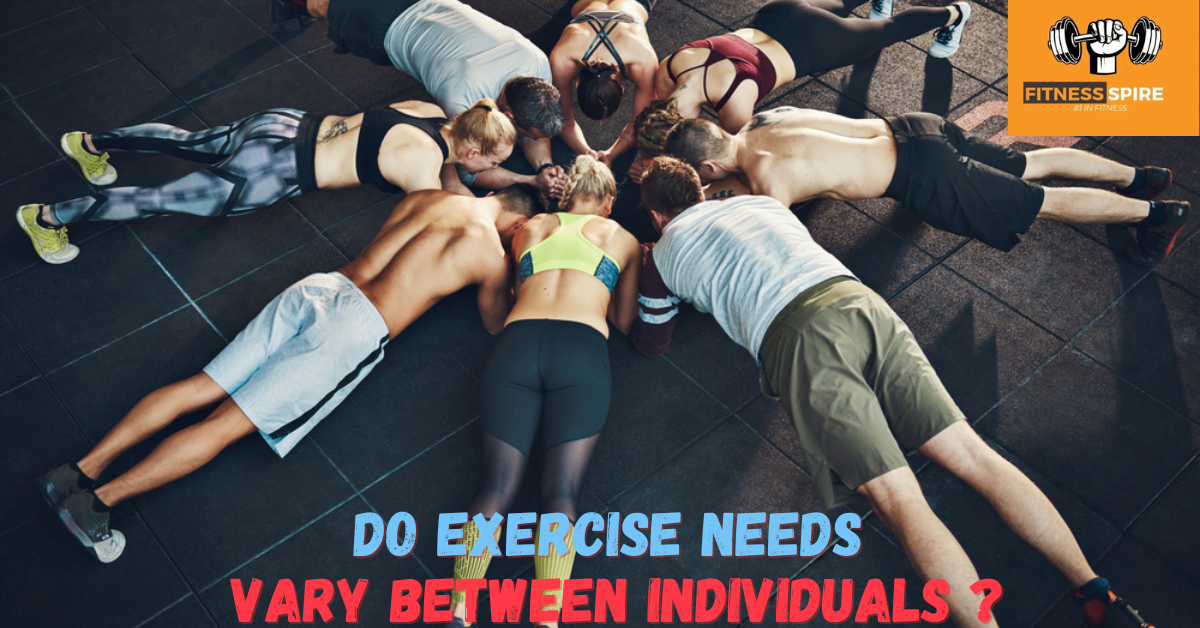Your Ultimate Destination for Fitness

Unlocking the Mystery: Why Do Exercise Needs Vary Between Individuals

1. Introduction
Why Do Exercise Needs Vary Between Individuals? Do you want to know why exercise needs vary so significantly between individuals? In this article, we will cover all the details about Why Exercise Needs Vary Between Individuals. So without wasting time let’s get started.
Table of Contents
2. Understanding Exercise Needs

Exercise needs refer to the specific requirements of an individual with physical activity. A combination of physiological, genetic, and lifestyle factors influenced these needs. It is crucial to consider these factors when designing exercise programs to ensure optimal results and reduce the risk of fatigue or injury.
3. Factors Influencing Exercise Needs
Following are the factors that shed light on the: Why Do Exercise Needs Vary Between Individuals
3.1 Age and Life Stage
Age plays a significant role in determining exercise needs. Children and adolescents have different requirements because of growth and development. As we get older, exercise becomes essential for maintaining overall health, preventing age-related decline, and preserving mobility and cognitive function in older adults. Adapting exercise routines to suit different life stages is crucial for meeting individual needs.
3.2 Health Conditions and Medical History
Individuals with pre-existing health conditions or medical histories may have specific exercise needs. Some conditions may require modifications to exercise programs to ensure safety and avoid exacerbating symptoms. Consulting with healthcare professionals can provide valuable insights into tailoring exercise plans that accommodate individual health considerations.
3.3 Genetics and Body Composition
Genetics and body composition contribute to variations in exercise needs between individuals. Our genetic makeup influences factors such as metabolism, muscle fiber types, and oxygen utilization capacity, affecting how our bodies respond to exercise. Body composition, including muscle mass and distribution of fat, can impact the type and intensity of exercise required. Understanding these genetic and physical factors allows for personalized exercise programs that maximize results.
3.4 Fitness Level and Goals
Fitness level and personal goals significantly influence exercise needs. Beginners may require a gradual approach to build strength, endurance, and flexibility. Intermediate individuals may aim to improve performance or achieve specific fitness goals. Advanced fitness enthusiasts or athletes may have more demanding exercise requirements to enhance their athletic abilities. Tailoring exercise programs based on fitness level and goals ensures effective progress and avoids plateaus or injury.
3.5 Lifestyle Factors and Preferences
Lifestyle factors and personal preferences also play a role in determining exercise needs. Occupations that involve prolonged sitting or physically demanding work may require additional exercises to counteract the effects or maintain a healthy balance. Individual preferences, such as preferred exercise modalities or environments, can affect motivation and adherence to a regular exercise routine. Taking these factors into account helps create enjoyable and sustainable exercise plans.
4. What are the advantages of individualized exercise?

When looking for the answer to why do exercise needs vary between individuals? The advantages of exercise are very significant. Staying healthy requires regular exercise. However, sometimes people cannot achieve the desired results. That is why personalized workout programs might be beneficial.
Tailored workouts or exercises match your specific needs, and preferences, with your desired level of participation. Personal exercise programs have many advantages. You can achieve your fitness objectives faster and more successfully than with a traditional training program.
5. Tailoring Exercise Programs
Recognizing the individual variations in exercise needs emphasizes the importance of tailoring exercise programs. A personalized approach accounts for factors such as age, health conditions, genetics, fitness levels, and lifestyle preferences. Working with fitness professionals or seeking guidance from qualified trainers can ensure that exercise programs are safe, effective, and aligned with individual goals.
6. Individual Variations in Exercise Needs
It is important to understand that everyone is unique, and exercise needs will vary from person to person. Embracing these individual variations promotes inclusivity and helps people find exercise routines that work best for them. By recognizing and accommodating diverse exercise needs, we can foster a more inclusive fitness culture that promotes overall well-being.
7. Frequently Asked Questions (FAQs)
FAQ 1: Why is it important to consider individual exercise needs?
Considering individual exercise needs is essential because it allows for the development of personalized exercise programs that optimize results and ensure safety. Customized exercise plans consider factors such as age, health conditions, genetics, fitness levels, and personal goals, leading to more effective outcomes.
FAQ 2: Can exercise needs change over time?
Yes, exercise needs can change. Factors such as age, lifestyle changes, health conditions, and personal goals can influence the intensity, duration, and type of exercise needed. Regular reassessment and adaptation of exercise programs ensure continued progress and address evolving needs.
FAQ 3: How can genetics influence exercise requirements?
Genetics can influence exercise requirements by determining factors such as metabolic rate, muscle fiber composition, and oxygen utilization capacity. Understanding genetic predispositions can help tailor exercise programs to leverage strengths and overcome potential limitations.
FAQ 4: What role does body composition play in exercise needs?
Body composition, including muscle mass, body fat percentage, and distribution, influences exercise needs. Individuals with different body compositions may require specific exercise strategies to achieve their desired outcomes. Consideration of body composition helps design targeted and effective exercise programs.
FAQ 5: Is there a specific exercise program suitable for everyone?
There is no such thing as a one-size-fits-all exercise program that is appropriate for everyone. Each individual’s exercise needs are unique and should be tailored to their specific requirements, goals, and abilities. A personalized approach ensures optimal results and promotes long-term adherence.
8. Conclusion
Understanding why do exercise needs vary between individuals is crucial for creating effective and personalized exercise programs. Factors such as age, health conditions, genetics, fitness levels, and personal preferences contribute to these variations. By acknowledging and accommodating individual differences, we can optimize exercise routines, promote inclusivity, and empower individuals to achieve their fitness goals. Remember, when it comes to exercise, one size does not fit all.



